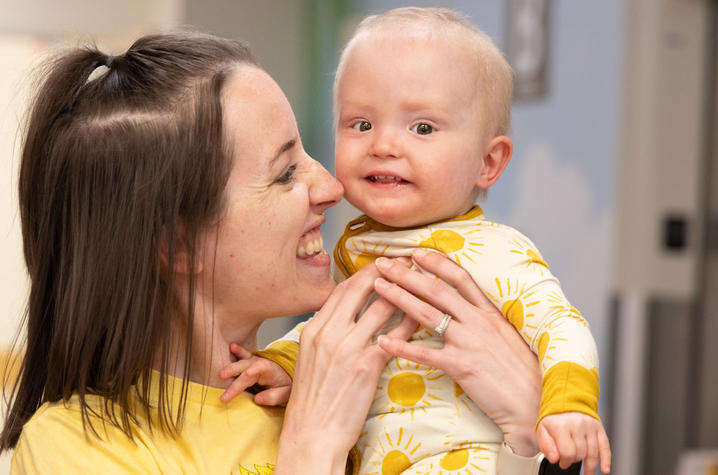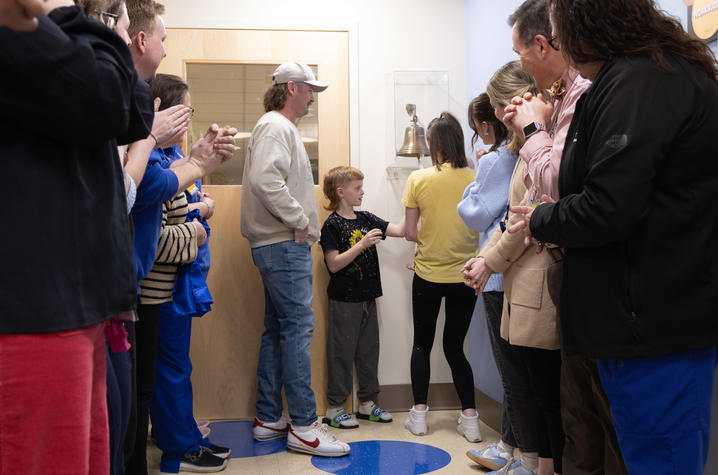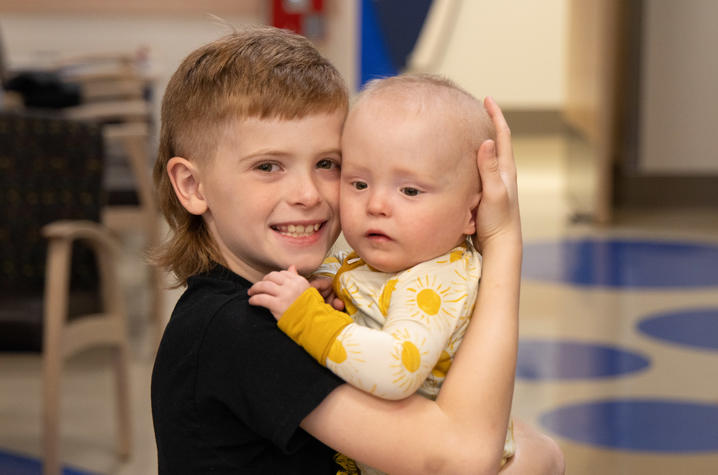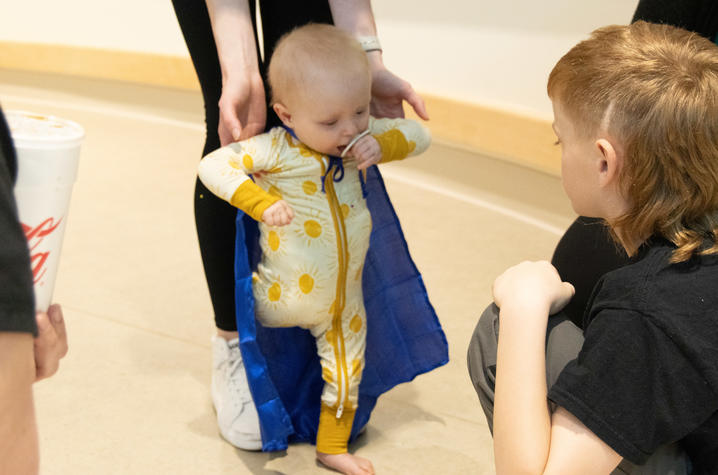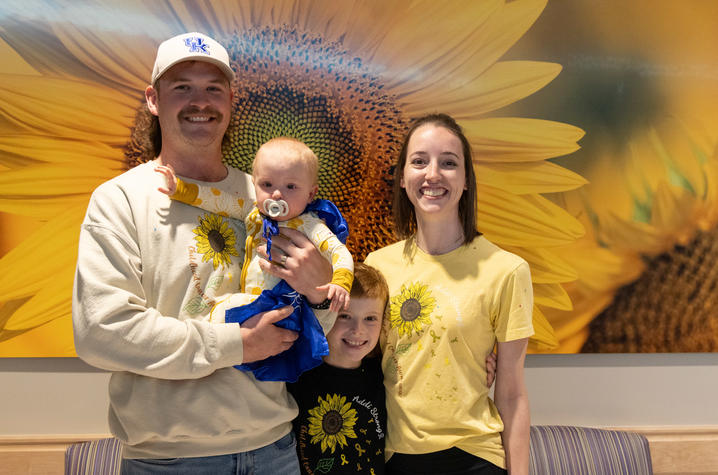‘She is soaring’ — young patient outshines cancer with strength and sunshine
LEXINGTON, KY. (June 2, 2025) — Addi Luedeke has experienced more in her 17 months than most people will in their entire lifetime.
But you would never know it, looking at this happy, smiley toddler from Richmond. She loves sunflowers, her big brother and scooting around the floor at top speed. After a premature birth, extended stay in the neonatal intensive care unit (NICU) at Kentucky Children’s Hospital (KCH) and a cancer diagnosis that took her right leg, Addi is determined to make up for lost time — at her own pace and in her own way.
A tough start, but Addi is tougher
The first half of Hannah Luedeke’s pregnancy was uneventful. She and her husband, Hunter, were excited to give their son, Brandon, a baby sister to play with. Around the 25-week mark in her pregnancy, Hannah experienced high blood pressure, one of the telltale signs of preeclampsia. A common but serious condition, preeclampsia can be fatal to both mother and baby; early delivery is usually recommended to keep both the mother and baby safe. However, the timing of the delivery can be tricky. Deliver too early, and the baby is at risk for premature complications such as underdeveloped lungs. Deliver too late, and the organ damage experienced by the mother can be irreparable.
“I was admitted on Halloween morning, and I just figured they would get my blood pressure under control and tell me to take it easy,” said Hannah. “I was told they were going to keep me there until she was born.”
The goal was to keep Hannah’s blood pressure stable until the 28-week mark. But the maternal-fetal medicine team decided it was better to act sooner than later. A week after she was admitted, Hannah underwent an emergency cesarean section at 26 weeks and three days. Addi made her entrance to the world on Nov. 8, 2023.
An unexpected diagnosis
In the NICU, Addi grew quickly. She didn’t experience many of the complications that come with a premature birth, such as gastrointestinal issues or underdeveloped lungs or eyes. She had a minor brain bleed that resolved on its own. Hannah and Hunter were counting down the days until they could bring her home. The winter of late 2023 and early ’24 had higher-than-average respiratory illness rates; as a result, visitation to the NICU was restricted, so Addi’s big brother couldn’t visit as much as he wanted to. Still Hannah and Hunter were grateful for a smooth stay in the NICU.
But in March, everything turned upside down.
Hannah had noticed swelling in around Addi’s right hip and upper thigh. Premature babies are prone to swelling, but this seemed different. As a respiratory therapist, Hannah knew the importance of early intervention and asked for imaging. Thinking perhaps Addi experienced some trauma to her hip and leg during the whirlwind that was her delivery, Hannah asked for MRIs, X-rays and an ultrasound. The result wasn’t what anyone could have expected.
“We had been talking about how easy the NICU days were compared to the other families there,” Hannah said. “I spoke too soon.”
“In mid-March of 2024 I became involved in Addi’s case during the evaluation of her unilateral thigh swelling,” said Alison Slone, M.D., neonatologist in the KCH NICU. “I vividly remember my attempt at a physical exam of this adorable wiggle worm in Hannah’s lap because this wasn’t the usual puffy extremity we often see in the NICU. I instantly shared in her mother’s worry for something more serious. Our clinical team worked together to expedite advanced imaging given the concern for a possible soft tissue mass or a tumor in her thigh.”
On March 18, 2024, Addi was diagnosed with a localized fusion negative rhabdomyosarcoma, a rare cancer that develops in soft tissues. She was barely 6 months old.
“It’s very rare to have rhabdo tumor this large in someone this young,” said Tom Badgett, M.D., Addi’s primary oncologist in the KCH DanceBlue Pediatric Hematology & Oncology Clinic.
“It grew pretty rapidly,” said Hannah. “We had pictures from February where you couldn’t see anything, and in the pictures from March, you could definitely see a big difference in the size of her legs.”
But how do you treat a rare cancer in a baby as young as Addi? After conferring with other pediatric oncology specialists, Addi began a 42-week chemotherapy regimen, with the goal of shrinking the tumor enough to where it could safely be surgically removed while also preserving her leg.
“There was weekly chemo; we’d have three chemos in one week,” Hannah said. “Then the following two weeks, just one chemo, then three again, then one again. Every three weeks, we would have to be admitted and stay overnight.”
After three months of this routine, new imaging revealed little change in the tumor’s size. Not only that, but the tumor, now roughly the size of a lime, was wrapped around Addi’s upper femur. If her surgical team tried to extract the tumor, they would also have to remove a significant portion of Addi’s muscle as well. After long conversations with specialists across multiple disciplines, including Patrick O’Donnell, M.D., an orthopedic oncology surgeon who specializes in tumors that occur in bones and soft tissues, the decision was made to amputate Addi’s right leg.
The decision was hard, but Hannah knows it was the right one.
“Once they got in there, they saw the tumor was covered in vessels and wrapped and positioned in such a way that there would have been no way to safely remove it,” Hannah said.
Signs of strength
Although Hannah was living every parent’s nightmare, she found comfort in unexpected places.
“My favorite flower is the sunflower,” she said. “When I found out I was having a girl, I decorated her nursery with sunflowers and bumblebees. We called her our ‘sunshine baby.’”
After Addi’s diagnosis, Hannah wanted to make shirts and ribbons for the family to wear to support her in treatment. And the color associated with rhabdomyosarcoma? Sunflower gold.
There were other signs as well. Hannah started seeing cardinals everywhere — in trees, on license plates, tattooed on a friend — appearing at times when Hannah needed comfort the most.
“I remembered seeing something about the meaning of cardinals, and how they are sent from a loved one watching over you,” Hannah said. “My grandpa passed away last year, and Addi has another grandpa in heaven. We’d be having a terrible week, knowing that Addi might need a transfusion, or she would be running a fever. I’m not someone who goes searching for signs, but every week I would see them on the way to the hospital, and we knew she had people from above sending signs that they were watching over her.”
In June 2024, at just seven months old, Addi already experienced a premature birth, a rare, fast-growing cancer and a complete amputation of her right leg. Four weeks after her amputation surgery, on July 24, Addi left the hospital for the first time in her life. In total, she had spent 259 days at KCH.
Hannah and Hunter were already impressed with Addi’s resilience in the hospital, but nothing could have prepared them for the version of Addi they saw once they were home.
“She was a completely different baby,” Hannah said. “Her energy improved, she didn’t sleep all day anymore. We thought she had chunky baby rolls, but it was just fluid retention from being sick. Everything that was wrong became better as soon as that tumor was gone. It was crazy.”
Meanwhile, Brandon was determined to make up for all the time the siblings had spent apart. Hannah says he dotes on Addi and is very involved in feedings, changing and Addi’s physical therapy exercises. This tough toddler hasn’t missed a beat; she’s already pulling herself up, sitting unassisted and getting ready to crawl.
“She really wants to scoot,” Hannah said. “She can pivot herself 360 degrees into a seated position if she needs to turn around to get somewhere else. She has figured out a way to move in a way that works for her.”
Addi will eventually be evaluated for a prosthetic, but Hannah said Addi will choose how she wants to move.
“With an amputation at the hip, it would be really hard for an adult to learn to use it,” she said. “But with her being so young, she should be able to use it pretty easily. But if she decides she doesn’t want to wear it and would rather use crutches, that’s cool too.”
Looking ahead with light
On March 24, Addi, surrounded by her entire extended family, rang the bell in the DanceBlue Clinic to celebrate the end of her cancer treatment. Moments later, they rang a second bell, this time in the NICU surrounded by the team that cared for her for the first few months of her life.
“We were deeply honored when the Luedekes chose to ring the bell again alongside her NICU caregivers at the end of her treatment,” said Slone. “This is a testament to the unique bonds created during times of significant stress. It’s also evidence of the exceptional psychosocial care we strive to provide for all families in our unit. Her neonatologists, primary nurses, advanced practice providers, therapists and all others in the NICU will be lifelong members of Team Addi Strong.”
For the next year, Addi will need to return to KCH every three months for scans, as there’s a chance the tumor could return. The frequency of the required imaging will decrease over the next five years.
For now, Addi continues with her physical therapy and is getting stronger and more independent with each day. Hannah, Hunter and Brandon work with her on stretches and exercises, but Addi lets them know who is in charge.
“She is soaring,” Hannah said. “She said, ‘I’m going to do it how I want and figure it out on my own terms.’ She just wants to go, go, go.”
UK HealthCare is the hospitals and clinics of the University of Kentucky. But it is so much more. It is more than 10,000 dedicated health care professionals committed to providing advanced subspecialty care for the most critically injured and ill patients from the Commonwealth and beyond. It also is the home of the state’s only National Cancer Institute (NCI)-designated Comprehensive Cancer Center, a Level IV Neonatal Intensive Care Unit that cares for the tiniest and sickest newborns and the region’s only Level 1 trauma center.
As an academic research institution, we are continuously pursuing the next generation of cures, treatments, protocols and policies. Our discoveries have the potential to change what’s medically possible within our lifetimes. Our educators and thought leaders are transforming the health care landscape as our six health professions colleges teach the next generation of doctors, nurses, pharmacists and other health care professionals, spreading the highest standards of care. UK HealthCare is the power of advanced medicine committed to creating a healthier Kentucky, now and for generations to come.





